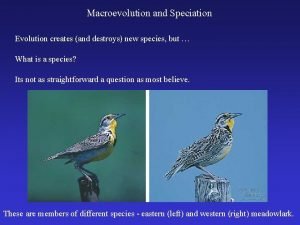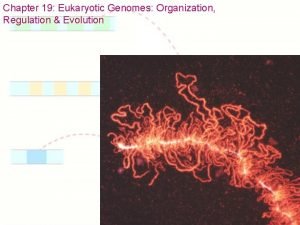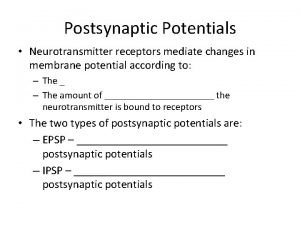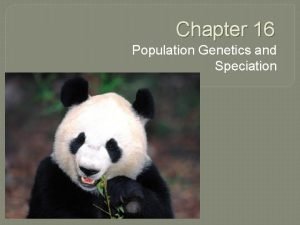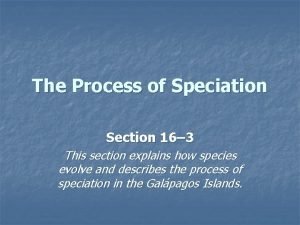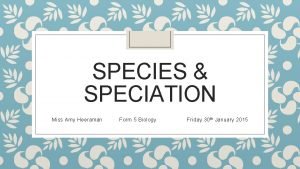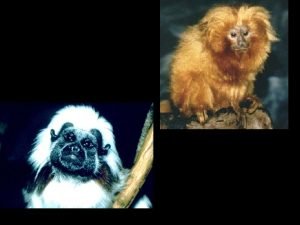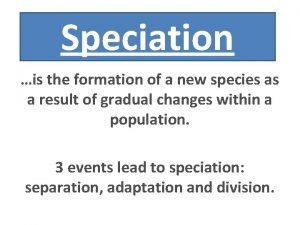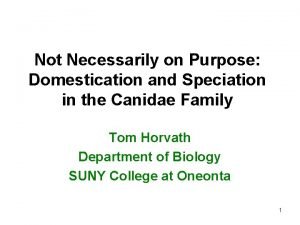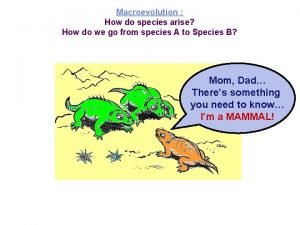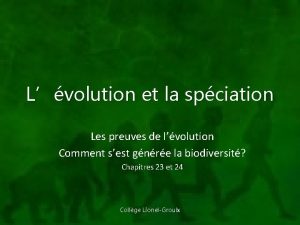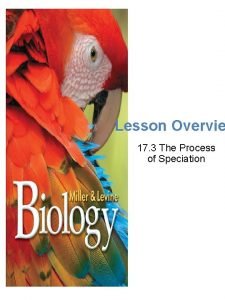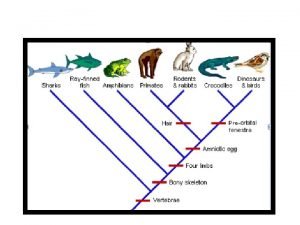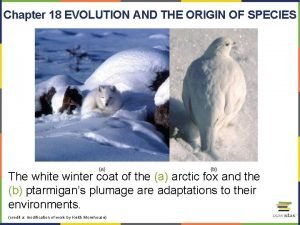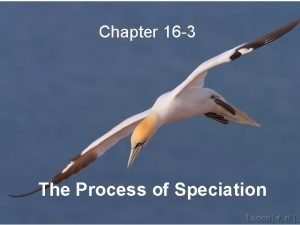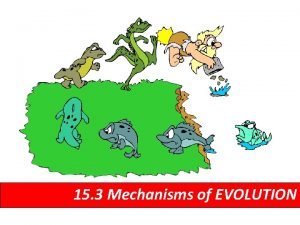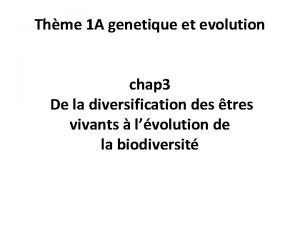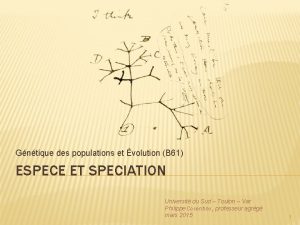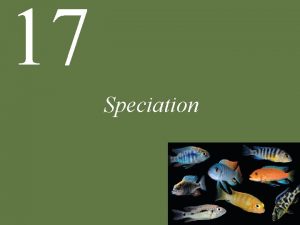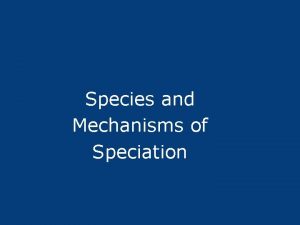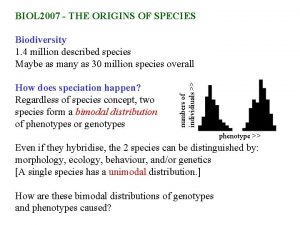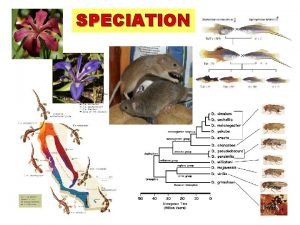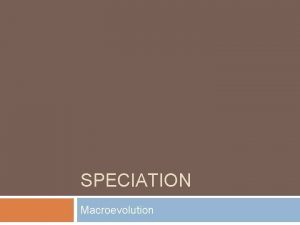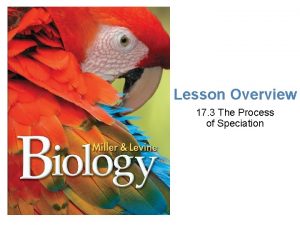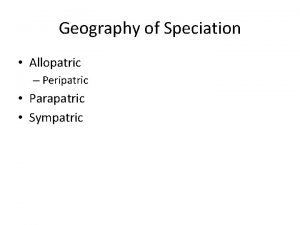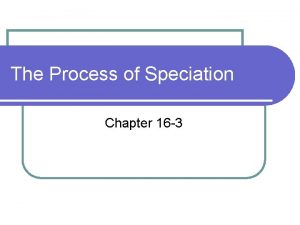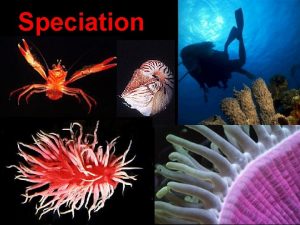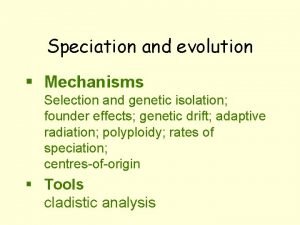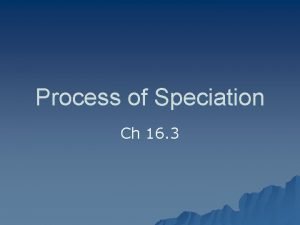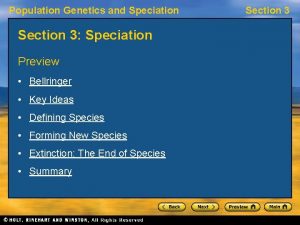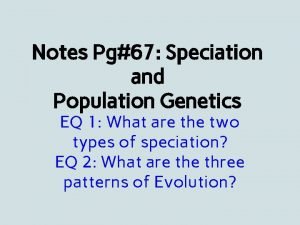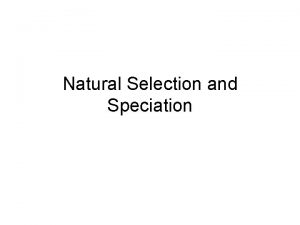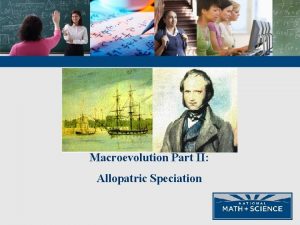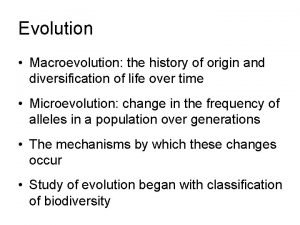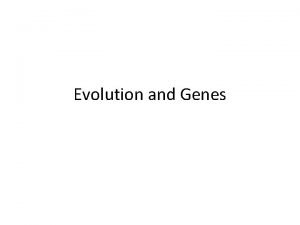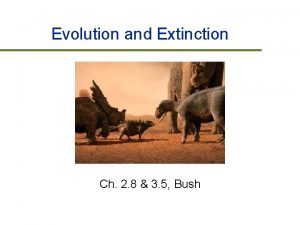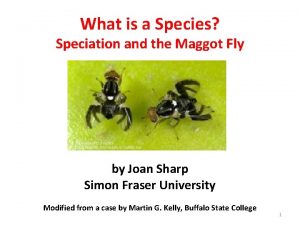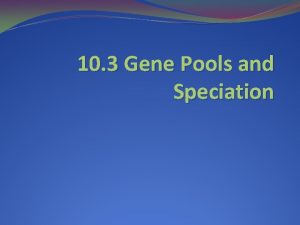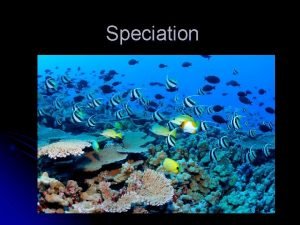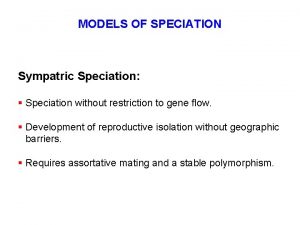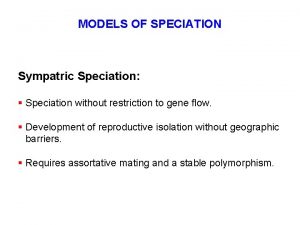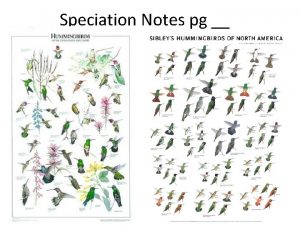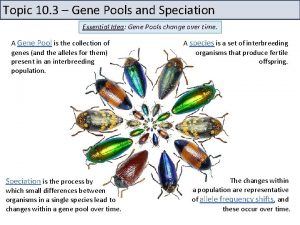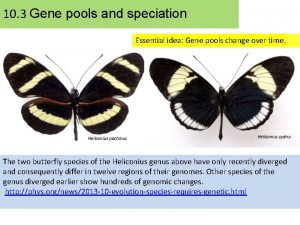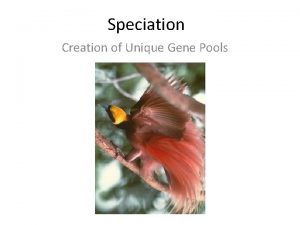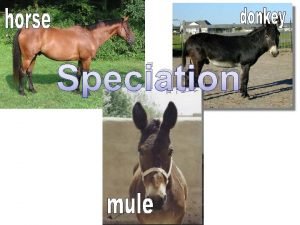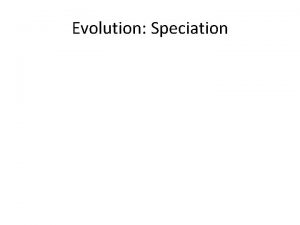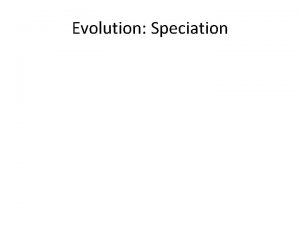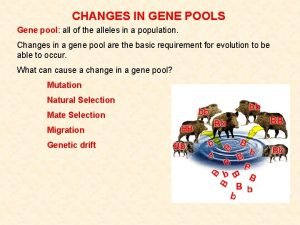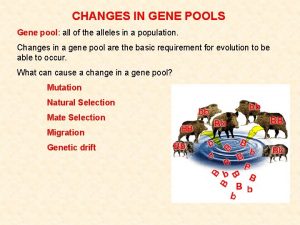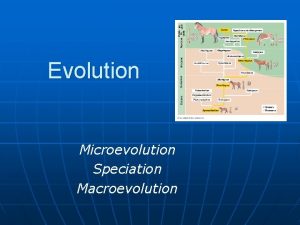10 3 GENE POOLS AND SPECIATION HL Evolution



































































- Slides: 67

10. 3 GENE POOLS AND SPECIATION HL Evolution

UNDERSTANDINGS Nature of science: Looking for patterns, trends and discrepancies—patterns of chromosome number in some genera can be explained by speciation due to polyploidy. (3. 1) • A gene pool consists of all the genes and their different alleles, present in an interbreeding population. • Evolution requires that allele frequencies change with time in populations. • Reproductive isolation of populations can be temporal, behavioral or geographic. • Speciation due to divergence of isolated populations can be gradual. • Speciation can occur abruptly. (IB guidance: punctuated equilibrium implies long periods without appreciable change and short periods of rapid evolution).

APPLICATIONS AND SKILLS • Application: Understand examples of directional, stabilizing, and disruptive selection. • Application: Explain speciation in the genus Allium by polyploidy. • Skill: Comparison of allele frequencies of geographically isolated populations.

RETRO-BIO 1. Describe the changes in beaks of finches on Daphne Major in the Galapagos Islands. 2. Comparison of the pentadactyl limb of mammals, birds, amphibians and reptiles with different methods of locomotion.

GALAPAGOS ISLANDS: 1000 KM OFF THE COAST OF ECUADOR IN THE PACIFIC OCEAN. PROVINCE OF ECUADOR.

CHARLES DARWIN VISITED THESE ISLANDS IN 1835 AND COLLECTED SPECIMENS OF These. SMALL birds turned out. BIRDS. to be finches. 14 species in all. Sizes and shapes of beaks varied as did their diet. From the overall similarities between the birds and their distribution over the islands, he hypothesized that they originally were one species that had been modified over time for different ends. Investigators, Peter and Rosemary Grant have shown that beak characters and diet are closely related and when one changes, the other does also. (Have spent 6 months each year since 1973 capturing, tagging, taking blood samples) Their focus has been a population of the medium ground finch, Geospiza fortis. Almost but not quite absent at this time was the small ground finch, G. fuliginosa. Both species feed on small seeds though G. fortis can also eat larger seeds.

SPECIES OF FINCH. 3 SEEN ON DAPHNE MAJOR AFTER 1982.

RETRO 1: DESCRIBE THE CHANGES IN BEAKS OF FINCHES ON DAPHNE MAJOR IN THE GALAPAGOS ISLANDS. IN 1973 2 SPECIES PRESENT: G. FORTIS AND G. FULIGINOSA. IN 1982 A 3 RD SPECIES COLONIZED: G. MAGNIROSTRIS

IN 1977, A DROUGHT ON DAPHNE MAJOR CAUSED A SHORTAGE OF SMALL SEEDS, SO G. FORTIS FED INSTEAD ON LARGER, HARDER SEEDS, WHICH THE LARGERBEAKED INDIVIDUALS WERE ABLE TO CRACK OPEN. Most of the population of G. fortis died that year, with the highest mortality among individuals with shorter beaks. In 1982 -3 there was a severe El Nino event, causing 8 months of heavy rain and as a result an increased supply of small, soft seeds and fewer large, hard seeds. G. fortis bred rapidly in response to the increase in food availability. With a return to dry weather conditions and greatly reduced supplies of small seeds, breeding stopped until 1987. Only 37% of 1983 population survived, but not a random sampling: 1987 G. fortis had longer and narrower beaks correlating with the reduction in supply of small seeds. Let’s look at the data.

BEAKS OF FINCHES ON DAPHNE MAJOR: BEAK SIZE IS DUE IN LARGE PART BY GENETIC FACTORS.


1982 -1983 SEVERE EL NINO EVENT WITH LOTS OF RAINFALL. FOLLOWED BY DRY CONDITIONS. 1987 birds had longer and narrower beaks than the 1983 birds, correlating with the reduction in supply of small seeds. In the case of Geospiza fortis significant changes have occurred that are clearly linked to natural selection.

RETRO 2: COMPARISON OF THE PENTADACTYL LIMB OF MAMMALS, BIRDS, AMPHIBIANS AND REPTILES WITH DIFFERENT METHODS OF LOCOMOTION.

PENTADACTYL LIMB IN MAMMALS Homologous structures in all vertebrates. Structures that superficially different and perform a different function, but which have had the same origin, from an ancestor that had a pentadactyl or five-digit limb, and that they have become different because they perform different functions. This is called adaptive radiation.

THE PENTADACTYL LIMB CONSISTS OF THESE STRUCTURES: Bone structure Forelimb Hindlimb Single bone in the proximal part humerus Femur Two bones in the distal part Radius and ulna Tibia and fibula Group of wrist/ankle bones carpals Tarsals Series of bones in each of 5 digits Metacarpals and phalanges Metatarsals and phalanges

COMPARISON Crocodiles (reptiles) walk or crawl on land use their webbed hind limbs for swimming Penguins (birds) use their hind limbs for walking and their forelimbs as flippers for swimming. Echidnas (mammals) use all 4 limbs for walking and also use their forelimbs for digging. Frogs (amphibians) use all 4 limbs for walking and their hindlimbs for jumping. Differences can be seen in the relative length and thicknesses of the bones. Some metacarpals and phalanges have been lost during the evolution of the penguin’s forelimb. Same bones, in the same relative positions.

GENE POOLS: CONSIST OF ALL THE GENES AND THEIR DIFFERENT ALLELES, PRESENT IN AN INTERBREEDING Species: a group of potentially interbreeding populations, with a POPULATION common gene pool that is reproductively isolated from other species. Some populations of the same species are geographically isolated so it is possible for multiple gene pools to exist for the same species. Individuals that reproduce contribute to the gene pool of the next generation. Evolution is defined as the cumulative change in the heritable characteristics of a population over time. That means that gene (or more specifically) allele frequencies change with time in populations.

HARDY WEINBERG THEOREM: WHY THE WORLD IS NOT SLOWLY BECOMING POLYDACTYLOUS The frequencies of alleles and genotypes in a population’s gene pool remain constant from generation to generation, provided that only Mendelian segregation and recombination of alleles are at work.

HARDY WEINBERG MODEL p = frequency of A q = frequency of a p + q = 1 so p = 1 - q If the frequency of A is p in a population that is large, randomly mating, with no mutation, migration, or natural selection the chances of bumping into another A in the gene pool are A x A or AA = p 2 and Aa = 2 pq and aa = q 2

WE CAN USE THIS THEOREM TO MAKE PREDICTIONS If q 2 = 0. 0001, then q =. 01, p = 0. 99 2 pq = 2(. 01 x. 99) = 0. 02 and Let’s use the Hardy Weinberg theory to calculate the frequency of heterozygotes for blue eyes. p 2 = 0. 99 x 0. 99 = 0. 98 Frequency of the tongue rolling and non-rolling gene? If carrier detection were important than when a test is devised, it should identify approximately 2% of the subjects as carriers. What other relatively neutral trait can we use?

MECHANISMS OF EVOLUTION OF ALLELE FREQUENCY CHANGE: MUTATION AND MIGRATION Mutation: creates genetic variation but does not change gene frequencies very fast Mutations of a particular gene occur on the order of 1 x 10 -4 or -5 Hb C in Central Africa; lactose tolerance in dairy herders of Northern Europe about 7, 000 years ago. Coupled with natural selection, can rapidly move through a population Migration: (also called gene flow) can cause an influx of a new gene that might spread throughout the population because it is novel or gives a selective advantage. Ex. We can follow the change in the frequency of the B blood type from the Steppes of Asia into Central Europe as a result of the invasion of the Mongols under Genghis Khan.

EXAMPLE OF THE EFFECTS OF MIGRATION: GROUP B ALLELE IN EUROPE

EFFECTS OF SMALL POPULATION SIZE, ALSO CALLED RANDOM GENETIC DRIFT, FOUNDERS EFFECTS, OR �Random Genetic Drift: due to random POPULATION BOTTLENECKS accumulation of genetic change because of small population size, inbreeding, genetic bottlenecks, or Founder’s Effect. �All of these are really a function of small population size and reduce genetic variability in a population. �Bottlenecks: Great cats being reduced to a very small number; Founder’s Effect: Dunker population in Pennsylvania with high frequency of dwarfish; South African Afrikaners: Porphyria. French Canadian: hereditary

DIAGRAMS ILLUSTRATING THE EFFECTS OF SMALL POPULATION SIZE: BOTTLENECKS AND DRIFT

MECHANISMS OF EVOLUTION: NATURAL SELECTION. CAN CHANGE GENE FREQUENCIES RAPIDLY Differential reproduction +/or survival of genotypes (i. e. natural selection as opposed to artificial selection practiced by plant breeders) Some genotypes cause individuals to die prior to reproduction or not produce viable offspring (Muscular dystrophy, Tay Sachs) Other genotypes might cause an individual to withstand an infection better, survive, & reproduce (Sickle cell disorder in malarial infested areas)

3 PATTERNS OF NATURAL SELECTION BASED ON THE FITNESS OF Selection pressures are environmental GENOTYPE/PHENOTYPE factors that act selectively on certain phenotypes resulting in natural selection. Stabilizing selection: selection pressures act to remove extreme phenotypes. Average birth weights of human babies are favored over low birth weight or high birth weight. Disruptive selection: selection pressures act to remove intermediate varieties, favoring extremes. Dark and light banding patterns in snails Directional Selection: the population changes as one extreme of a range of variation is better adapted. Big horn sheep

STABILIZING SELECTION AND DIRECTIONAL SELECTION TOWARD SMALLER HORNS IN BIG HORN SHEEP DUE TO TROPHY HUNTING (KILLING OF SHEEP WITH LARGER HORNS)

EXAMPLE OF DISRUPTIVE SELECTION

OTHER EXAMPLES GIVEN BY YOUR REVIEW GUIDE (PAGE 127) Directional Selection: Parus major (Great tit), breeding success has been greater with birds that breed early than with those that breed later because the peak availability of prey is earlier. Selection pressure to breed early. Stabilizing selection: Parus major, breeding success is greatest with intermediate clutch sizes (# of eggs) because in large clutches offspring have lower survival rates and in small clutches, fewer offspring with no greater chance of survival than in intermediate clutches. Disruptive selection: bird Passerina amoena (lazuli bunting). Year-old males with the dullest and brightest plumage are more successful than males with intermediate plumage at obtaining high-quality territories, pairing with females and siring offspring.

DIFFERENT POPULATIONS HAVE DIFFERENT ALLELE FREQUENCIES: PAN I GENE IN COD FISH Pantophysin found in membranes of small cytoplasmic vesicles Light grey: frequency of Pan IA Black sectors: frequency of Pan IB 1. State the 2 populations with the highest Pan IB allele frequencies. 2. Deduce the allele frequencies of a population in which half of the cod fish had the genotype Pan. IA, and half had the genotype Pan. IA Pan. IB. 3. Suggest two populations that are geographically isolated. 4. Suggest 2 possible reasons why the Pan. IB allele is more common in population 14 than

EXAMPLE OF POPULATIONS WITH DIFFERENT ALLELE FREQUENCIES PAGE 127 Frequency of gene delta F 508 (one of the alleles that causes cystic fibrosis) is 0. 04 in the Faroe Islands but only 0. 03 in northern Europe and below 0. 01 in most other parts of the world.

SPECIATION THROUGH REPRODUCTIVE ISOLATION: GEOGRAPHIC, TEMPORAL, BEHAVIORAL Speciation is the formation of a new species by the splitting of an existing population. Gene pools can become isolated by various barriers and speciation can occur when this happens. If the isolation occurs because of geographic separation of populations, this is termed allopatric speciation.

HOW DO THEY GET ISOLATED?

ALLOPATRIC SPECIATION THROUGH GEOGRAPHIC ISOLATION Antelope squirrels on opposite rims of the grand canyon.

WHAT COULD HAPPEN WHEN GENE POOLS BECOME ISOLATED? While allopatric: Could have a new mutation that changes a trait such as smell or behavior

BEHAVIORAL ISOLATION Eastern meadowlark and the western meadowlark have similar body shape and coloration. They are distinct species because their songs and other behaviors are different enough to prevent interbreeding.

TEMPORAL ISOLATION: CAN OCCUR TO POPULATIONS IN THE SAME AREA 3 tropical orchid species of the genus Dendrobium each flower for a single day Flowering occurs in response to sudden drops in temperature in all three species. The lapse between the stimulus and flowering is 8 days in one species, 9 days in another species and 10 -11 in the third. Isolation of the gene pools occurs, because at the time the flowers of one species are open, those of the other species have already withered or have not yet matured. Some cicada species only breed every 13 th year. If some breed with each other in a different year from the rest of the species, they will be isolated.

SYMPATRIC SPECIATION Mechanisms include: Chromosomal changes (polyploidy in plants) and Non-random mating that reduces gene flow. (e. g. mate selection based on coloration in

A POLYPLOID ORGANISM IS ONE THAT HAS MORE THAN 2 SETS OF HOMOLOGOUS CHROMOSOMES 1. Can result from hybridization events between different species. 2. Polyploids whose chromosomes originate from the same ancestral species. This can occur when chromosomes duplicate in preparation for meiosis but then meiosis does not occur. The result is a diploid gamete that when fused with a haploid gamete produces a fertile offspring (3 n). The 3 n offspring will not be capable of mating with the 2 n or 4 n individual so has become it’s own species. As a result the polyploid has become reproductively isolated from the rest of the population. A polyploid plant may self-fertilize or combine with other polyploids. Estimates of the number of species of angiosperms that have experienced a polyploidy event range from 50 -70% The Allium genus includes onions, leeks, garlic, and chives (important foods in many cultures). Polyploidy events are common in this genus.

SPECIATION IN THE ALLIUM FAMILY (GARLIC) BY POLYPLOIDY

MANY SPECIES OF ALLIUM REPRODUCE ASEXUALLY AND POLYPLOIDY MAY CONFER AN ADVANTAGE OVER DIPLOIDY. Wild onion is a native of North America. 2 n = 14. Variants exist that have 2 n = 28 Two species that occur in Lithuania. One of them has a 2 n = 16. The other has one with 2 n = 32.

SO…HOW FAST DOES SPECIATION OCCUR? Two theories about the pace of evolutionary change: A. Gradualism: theory that species slowly change through a series of intermediate forms…. think evolution of the horse or cranial capacity in humans. Dominant framework in paleontology. However there are gaps in the fossil record i. e. absence of intermediate forms.

B. PUNCTUATED EQUILIBRIUM: LONG PERIODS OF RELATIVE STABILITY IN A SPECIES PUNCTUATED BY PERIODS OF RAPID EVOLUTION. Gaps in the fossil record might not be gaps. Rapid change is much more common in organisms with short generation times like prokaryotes and insect.

10. 3. 1 DEFINE GENE POOL, EVOLUTION, SPECIATION Gene Pool: all the genes and their different alleles, present in an interbreeding population. Evolution: Cumulative change in the heritable characteristics of a population over time or the changes in the allele frequencies of a gene in a population over time. Speciation: formation of a new species by the splitting of an existing population.

10. 3. 2 DEFINE THE FOLLOWING PATTERNS OF NATURAL SELECTION: STABILIZING, DISRUPTIVE AND DIRECTIONAL (USE GRAPHS WITH GENE Selection pressures are environmental FREQUENCY ON X AND FREQUENCY OF factors that act selectively on certain INDIVIDUALS ON Y AXES) phenotypes resulting in natural selection. Stabilizing selection: selection pressures act to remove extreme phenotypes. EG average birth weights of human babies are favored over low birth weight or high birth weight. Disruptive selection: selection pressures act to remove intermediate varieties, favoring extremes. EG Dark and light banding patterns in snails Directional Selection: the population changes as one extreme of a range of variation is better adapted. EG Big horn sheep horn length.

10. 3. 3 IDENTIFY EXAMPLES OF EACH OF THE PATTERNS OF NATURAL SELECTION LISTED IN 10. 3. 2

DISRUPTIVE SELECTION: BIRD PASSERINA AMOENA (LAZULI BUNTING). YEAR-OLD MALES WITH THE DULLEST AND BRIGHTEST PLUMAGE ARE MORE SUCCESSFUL THAN MALES WITH INTERMEDIATE PLUMAGE AT OBTAINING HIGHQUALITY TERRITORIES, PAIRING WITH FEMALES AND SIRING OFFSPRING. Directional Selection: Parus major (Great tit), breeding success has been greater with birds that breed early than with those that breed later because of the peak availability of prey is not earlier. Selection pressure to breed early. Stabilizing selection: Parus major, breeding success is greatest with intermediate clutch sizes (# of eggs) because in large clutches offspring have lower survival rates and in small clutches, fewer offspring with no greater chance of survival than in intermediate clutches.

10. 3. 4 CALCULATE ALLELE FREQUENCIES IN A POPULATION OF RANDOMLY MATING INDIVIDUALS If you are given q , you can find q, p and 2 all of the other genotypic frequencies. 1. If, in a sampling of 1000 people, 810 had no dimples (dimples is a dominant trait), then what is the frequency of the D allele? What is the frequency of d? q=0. 9 p=0. 1 2. If there exist a population of mice, 108 of which were BB (for long bristles), 269 were Bb (medium) and 163 were bb (short bristles). Calculate the genotypic frequencies and the 2 allele frequencies. BB = 0. 2, Bb 0. 5, bb =0. 3 B = (108 x 2 +269)/1080 = 0. 45 b = (163 x 2 +269)/1080 = 0. 55

10. 3. 5 COMPARE ALLOPATRIC AND SYMPATRIC SPECIATION Allopatric: Speciation event that occurs with geographic isolation of populations. Sympatric: Speciation even that occurs while populations are in same geographic area

10. 3. 5 (I MISNUMBERED SOME OF THESE ): OUTLINE VARIOUS FORMS OF REPRODUCTIVE ISOLATION USING ONE EXAMPLE OF EACH (TEMPORAL, BEHAVIORAL, 3 tropical orchid species of the genus Eastern meadowlark and the Dendrobium each flower for a single day western meadowlark have similar GEOGRAPHIC). body shape and coloration. They Flowering occurs in response to sudden drops in temperature in all three species. The lapse between the stimulus and flowering is 8 days in one species, 9 days in another species and 10 -11 in the third. Isolation of the gene pools occurs, because at the time the flowers of one species are open, those of the other species have already withered or have not yet matured. Some cicada species only breed every 13 th year. If some breed with each other in a different year from the rest of the species, they will be isolated. are distinct species because their songs and other behaviors are different enough to prevent interbreeding. EG Antelope squirrels on opposite rims of the grand canyon (geographic). Species have accumulated genetic differences as a result of geographic isolation (barrier is the grand canyon).

10. 3. 6 OUTLINE 2 THEORIES ABOUT THE PACE OFabout the pace of Two theories evolutionary change: EVOLUTIONARYA. CHANGE. Gradualism: theory that species slowly change through a series of intermediate forms…. think evolution of the horse or cranial capacity in humans. Dominant framework in paleontology. However there are gaps in the fossil record i. e. absence of intermediate forms. B. Punctuated Equilibrium: long periods of relative stability in a species punctuated by periods of rapid evolution Gaps in the fossil record might not be gaps. Rapid change is much more common in organisms with short generation times like prokaryotes and insect.

10. 3. 7 DESCRIBE HOW POLYPLOIDY CAN LEAD TO SPECIATION WITH RESPECT TO THE GENUS ALLIUM

SYMPATRIC SPECIATION Mechanisms include: Chromosomal changes (polyploidy in plants) and Non-random mating that reduces gene flow. (e. g. mate selection based on coloration).

A POLYPLOID ORGANISM IS ONE THAT HAS MORE THAN 2 SETS OF HOMOLOGOUS CHROMOSOMES 1. Can result from hybridization events between different species. 2. Polyploids whose chromosomes originate from the same ancestral species. This can occur when chromosomes duplicate in preparation for meiosis but then meiosis does not occur. The result is a diploid gamete that when fused with a haploid gamete produces a fertile offspring (3 n). As a result the polyploid has become reproductively isolated from the rest of the population. A polyploid plant may self-fertilize or combine with other polyploids. Estimates of the number of species of angiosperms that have experienced a polyploidy event range from 50 -70% The Allium genus includes onions, leeks, garlic and chives (important foods in many cultures). Polyploidy events are common in this genus.

SPECIATION IN THE ALLIUM FAMILY (GARLIC) BY POLYPLOIDY

MANY SPECIES OF ALLIUM REPRODUCE ASEXUALLY AND POLYPLOIDY MAY CONFER AN ADVANTAGE OVER DIPLOIDY. Wild onion is a native of North America. 2 n = 14. Variants exist that have 2 n = 28 Two species that occur in Lithuania. One of them has a 2 n = 16. The other has one with 2 n = 32.

S 1 INTERPRETING ALLELE FREQUENCIES: SOME PRACTICE

1. G ALLELE: BLUE EYE A ALLELE: BROWN EYE 2. A ALLELE: DRY EARWAX G ALLELE: WET, STICKY

HUMAN GENOME DIVERSITY PROJECT ALLELE FREQUENCIES FOR ALLELES THAT AFFECT A) HANDLING UV LIGHT AND B) SKIN PIGMENTATION (ANCESTRAL YELLOW, DERIVED ALLELE IS DARK BLUE)

RETRO 1: DESCRIBE THE CHANGES IN BEAKS OF FINCHES ON DAPHNE MAJOR IN THE GALAPAGOS SPECIES OF FINCH. 3 SEEN ON DAPHNE MAJOR AFTER 1982. Peter and Rosemary Grant have shown that beak characters and diet are closely related and when one changes, the other does also. Their focus has been a population of the medium ground finch, Geospiza fortis. This species prefers small seeds.

IN 1977, A DROUGHT ON DAPHNE MAJOR CAUSED A SHORTAGE OF SMALL SEEDS, SO G. FORTIS FED INSTEAD ON LARGER, HARDER SEEDS, WHICH THE LARGERBEAKED INDIVIDUALS ARE ABLE TO CRACK OPEN. Most of the population of G. fortis died that year, with the highest mortality among individuals with shorter beaks. In 1982 -3 there was a severe El Nino event, causing 8 months of heavy rain and as a result an increased supply of small, soft seeds and fewer large, hard seeds. G. fortis bred rapidly in response to the increase in food availability. With a return to dry weather conditions and greatly reduced supplies of small seeds, breeding stopped until 1987. Only 37% of 1983 population survived, but not a random sampling: 1987 G. fortis had longer and narrower beaks correlating with the reduction in supply of small seeds.


1982 -1983 SEVERE EL NINO EVENT WITH LOTS OF RAINFALL. FOLLOWED BY DRY CONDITIONS 1987 birds had longer and narrower beaks than the 1983 birds, correlating with the reduction in supply of small seeds. In the case of Geospiza fortis significant changes have occurred that are clearly linked to natural selection.

R 2 COMPARISON OF THE PENTADACTYL LIMB OF MAMMALS, BIRDS, AMPHIBIANS AND REPTILES WITH DIFFERENT Homologous structures in all METHODS OF LOCOMOTION vertebrates. Structures that superficially different and perform a different function, but which have had the same origin, from an ancestor that had a pentadactyl or five-digit limb, and that they have become different because they perform different functions. This is called adaptive radiation.

THE PENTADACTYL LIMB CONSISTS OF THESE STRUCTURES: Bone structure Forelimb Hindlimb Single bone in the proximal part humerus Femur Two bones in the distal part Radius and ulna Tibia and fibula Group of wrist/ankle bones carpals Tarsals Series of bones in each of 5 digits Metacarpals and phalanges Metatarsals and phalanges

RETRO 2: COMPARISON OF THE PENTADACTYL LIMB OF MAMMALS, BIRDS, AMPHIBIANS AND REPTILES WITH DIFFERENT METHODS OF LOCOMOTION.

COMPARISON Crocodiles (reptiles) walk or crawl on land use their webbed hind limbs for swimming Penguins (birds) use their hind limbs for walking and their forelimbs as flippers for swimming. Echidnas (mammals) use all 4 limbs for walking and also use their forelimbs for digging. Frogs (amphibians) use all 4 limbs for walking and their hindlimbs for jumping. Differences can be seen in the relative length and thicknesses of the bones. Some metacarpals and phalanges have been lost during the evolution of the penguin’s forelimb. Same bones, in the same relative positions.
 Sympatric speciation vs allopatric speciation
Sympatric speciation vs allopatric speciation Gene by gene test results
Gene by gene test results Chapter 17 gene expression from gene to protein
Chapter 17 gene expression from gene to protein Gene evolution
Gene evolution Lakes and ponds ecosystem
Lakes and ponds ecosystem Pool y lane en bpmn
Pool y lane en bpmn Industrialists of the late 1800s used pools and trusts to
Industrialists of the late 1800s used pools and trusts to Industrialists of the late 1800s used pools and trusts to
Industrialists of the late 1800s used pools and trusts to An example of an activity cost pool is
An example of an activity cost pool is Viosslot
Viosslot Spinal cord
Spinal cord Spatial summation and temporal summation
Spatial summation and temporal summation Neural circuits the organization of neuronal pools
Neural circuits the organization of neuronal pools Relative vs absolute refractory period
Relative vs absolute refractory period Which neuron is rare
Which neuron is rare Neuronal pools
Neuronal pools Ddp raid
Ddp raid What is tbm?
What is tbm? Neural circuits the organization of neuronal pools
Neural circuits the organization of neuronal pools Cost accumulation and cost assignment
Cost accumulation and cost assignment Dynamic disk pool
Dynamic disk pool Buzz ghiz
Buzz ghiz Gareth james pools
Gareth james pools Frosts simple style is deceptive and a thoughtful reader
Frosts simple style is deceptive and a thoughtful reader Pool pros mitc
Pool pros mitc Pools industrialization definition
Pools industrialization definition Trihalomethanes in swimming pools
Trihalomethanes in swimming pools What are neuron processes
What are neuron processes Population genetics and speciation worksheet answer key
Population genetics and speciation worksheet answer key Modes of speciation ppt
Modes of speciation ppt Speciation
Speciation Taxonomic species concept
Taxonomic species concept Speciation, or the formation of new species, is
Speciation, or the formation of new species, is Allopatric speciation example
Allopatric speciation example Factors affecting gene frequency slideshare
Factors affecting gene frequency slideshare Artificial speciation
Artificial speciation Types of speciation
Types of speciation La spéciation
La spéciation Speciation process
Speciation process Speciation
Speciation Ecological speciation
Ecological speciation The origin of species chap 18
The origin of species chap 18 16-3 the process of speciation
16-3 the process of speciation Coevolution examples
Coevolution examples Dérive genetique
Dérive genetique Speciation ecureuil antilope
Speciation ecureuil antilope Embryo development
Embryo development Speciation
Speciation Assortative
Assortative Sympatric speciation
Sympatric speciation Ring species
Ring species Speciation process
Speciation process Speciation process
Speciation process Parapatric speciation
Parapatric speciation Sympatric speciation
Sympatric speciation Section 16-3 the process of speciation answer key
Section 16-3 the process of speciation answer key Speciation modes answer key
Speciation modes answer key Parapatric speciation
Parapatric speciation Speciation
Speciation Section 16-3 the process of speciation
Section 16-3 the process of speciation Modes of speciation ppt
Modes of speciation ppt Speciation
Speciation Speciation
Speciation Mechanical isolation example
Mechanical isolation example Huahaca
Huahaca Parallele evolution
Parallele evolution Modes of speciation ppt
Modes of speciation ppt Mechanical isolation
Mechanical isolation
